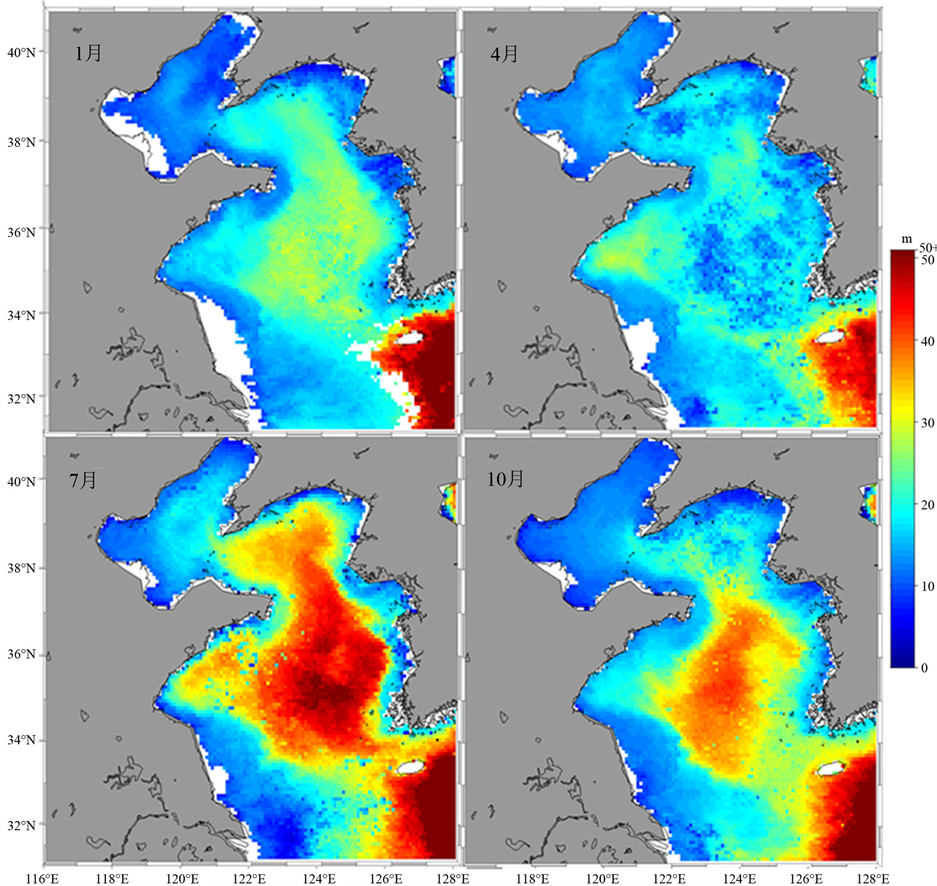1. 引言
真光层(Euphotic Zone Depth, Zeu)是指有足够穿透光线提供有效光合作用的水体上层[1] 。由于浮游植物大多分布在真光层,研究真光层对海洋初级生产力的估算起着重要作用,在水体生态环境,全球碳循环,以及全球气候变化研究中都有重要意义。同时,真光层深度的分布同水团性质也相关,可用来示踪水团和海流[2] 。真光层深度同水体浑浊程度相关,但是比透明度更能准确地描述光线衰减程度,并且比透明度更容易遥感反演,在海洋军事、海洋工程领域有重要意义[3] [4] 。真光层深度一般用光合有效辐射(Photosynthetic Available Radiation, PAR)衰减到表面值1%时对应的深度来表示[5] 。PAR一般指400~700 nm的太阳辐射部分,约占到达地球表面太阳总辐射的一半。由于海水中浮游植物、无机悬浮物、黄色物质的存在,可见光在海水中的衰减非常迅速。不同区域海水中,悬浮颗粒物类型、粒径分布、浓度等差别较大,导致真光层深度也差别很大。
真光层深度的测量方法有很多,可以直接测量水下光谱,也可以由透明度经验计算[6] 。测量水下光谱较为准确,但是操作较为复杂。透明度方法操作简单,计算简便,但是准确度不高。两种方法都无法大面积同步获取海水真光层的深度,且出海观测成本较高。水体散射可见光携带着水中成分信息,可用于计算浑浊程度,即可以用于反演计算真光层深度。随着遥感技术的发展,遥感反演真光层深度逐渐普遍。真光层深度的遥感计算方法主要有两种模式:一种是经验模式,真光层深度同水中成分(叶绿素、悬浮物和可溶有色物质浓度)之间有着较好的相关性,可以通过成分计算真光层深度[7] [8] 。另外一种是辐射衰减机理模式,利用真光层深度与海水漫衰减系数之间的关系,再根据辐射传输定律算出真光层深度。黄渤海浑浊水体,水中成分反演本身就不准确,由此计算的真光层会更加不准,因此本文使用机理反演模式。
黄渤海由于特殊的地理环境,其悬浮无机物、浮游植物和黄色物质浓度都很高,其海洋光学特性有很大的时空变化性。黄海平均水深40米,最大水深为86米,渤海是中国的内海,基本上为陆地所怀抱,仅东部以渤海海峡与黄海相通,面积7.7万平方公里,平均深度仅为18米。黄渤海的悬浮物质浓度从差别可达到3个数量级,透明度从几十厘米达到了几十米[9] 。黄渤海周边有众多河流,如海河、辽河、长江、淮河、黄河、鸭绿江等,将大量悬浮颗粒物质带入到海洋。
目前东海、南海真光层深度,甚至一些内陆湖泊真光层深度,都有了一些很好的研究,但是对于人类活动极为密切的黄海和渤海,其真光层深度却未见报道。本文尝试利用SeaWiFS气候态月平均漫衰减系数Kd (490)数据,依据真光层反演机理模式,反演出黄海、渤海的真光层气候态月分布,并分析了其空间分布原因。
2. 数据和方法
本文使用的数据为美国航空航天局(NASA)提供的宽视场海洋观测传感器(SeaWiFS)反演的气候态月平均漫衰减系数Kd (490)。SeaWiFS于1997年8月1日发射,正常工作时间为1997年9月18日到2010年12月11日,服役时间超过13年。SeaWiFS含有8个可见光和近红外通道,主要用于探测海洋水色,其星下点分辨率为1.1 km。向下辐照度的漫衰减系数Kd (490)是海色遥感标准产品之一,主要描述可见光在水体的穿透能力。Kd (490)海色遥感标准算法是基于蓝(490 nm)绿(555 nm)波段比值的经验算法,在对数坐标下其相关性R2达到0.931~0.937,在线性坐标下均方跟误差为0.012 m−1 [10] 。黄渤海水体较为浑浊,其反演精度可能会略有降低,但反演透明度的时空分布特征不会有太大差异。海色卫星受到云覆盖影响,很多区域没有观测数据,为最大限度地提高空间覆盖率,本文使用气候态月平均数据。
光线在性质均匀的水体中传输时符合Lambert-Beer定律,即辐照度随着深度的增加呈指数衰减[11] :
 (1)
(1)
其衰减系数(此处以PAR为例)可表示为:
 (2)
(2)
其中, 为0~z m深度的平均PAR漫射衰减系数
为0~z m深度的平均PAR漫射衰减系数 ,
, 为从海面到测量处的深度(m),
为从海面到测量处的深度(m), 为深度
为深度 处的向下光谱辐照度
处的向下光谱辐照度 ,
, 为水面以下向下光谱辐照度
为水面以下向下光谱辐照度 。
。
真光层深度是指光合有效辐射PAR衰减到表层量值的1%的深度。假定真光层深度为 ,由上式可推导出如下真光层深度计算[12]
,由上式可推导出如下真光层深度计算[12]
 (3)
(3)
大量研究证明, 和
和 之间的关系有很好的线性关系,可表示为:
之间的关系有很好的线性关系,可表示为:
 (4)
(4)
因此真光层深度可表示为:
 (5)
(5)
 为400~700 nm可见光范围光谱总辐照度的漫射衰减系数,是各个波段漫射衰减系数的加权平均值,但由于不同波段漫射衰减系数并不存在明确的线性关系,因此,对于不同海区,
为400~700 nm可见光范围光谱总辐照度的漫射衰减系数,是各个波段漫射衰减系数的加权平均值,但由于不同波段漫射衰减系数并不存在明确的线性关系,因此,对于不同海区, 和
和 之间的统计系数m并不相同。
之间的统计系数m并不相同。
李国胜等[13] 利用《渤海、黄海、东海海洋图集——水文分册》实测数据,分析透明度,真光层深度和光谱衰减系数得出黄渤海m约为1.311,即:
 (6)
(6)
3. 结果与讨论
由于云覆盖的影响,或太阳耀斑的影响,海色遥感数据存在或多或少的空白数据。图1为SeaWiFS数据计算的冬季(1月),春季(4月),夏季(7月),秋季(10月)13年平均气候态的真光层深度。可以看出即使观测时间长达13年,近岸很多区域仍然没有观测数据。
从图1可以看出,黄渤海真光层具有很大的时空变化性。总体来说,渤海真光层要小于黄海。渤海真光层冬季最浅基本都在10 m以下,夏季最深,最大真光层在20 m左右。黄海真光层深度春季最小,基本都在20 m以下,夏季真光层大多数区域都在40 m以上。
3.1. 渤海真光层时空变化特点及成因
渤海真光层非常浅主要由其独特环境造成的。渤海面积很小,离岸较近,且水深很浅,平均水深仅为18 m。渤海有辽河、滦河、海河、黄河等携带大量泥沙流入,并且渤海深处内海,与外界水体交换速率较低,使得渤海的悬浮物含量较高,可见光不能穿透太深。其次渤海周围为人类活动剧烈,认为排放的有机污染物较多,造成生态环境脆弱,赤潮频发,这同样降低了真光层深度。渤海沿岸流呈逆时针方向,从渤海流入黄海的沿岸流经过烟台威海沿岸,使得此处的水体较为浑浊,真光层深度也较浅。
在季节变化上,可以看出渤海冬季真光层最浅,基本都在10 m以下,这主要因为受冬季季风影响,渤海水深较浅,垂直混合较为强烈,将底层的颗粒物质带到了上层,加剧了光线衰减。而夏季风速相对较小,垂直混合较弱,并且水温很高,渤海会出现层化,上层颗粒物含量相对较少,因此真光层最大。同时在夏季和秋季,在渤海靠近胶东半岛渤海海峡区域,可以看到很明显的由黄海深入渤海的较深的真光层。黄海的水体透明度要明显高于渤海的水体,因此此处的真光层深度也要明显高些。
3.2. 黄海真光层时空变化特点及成因
黄海真光层基本趋势为越靠近岸边真光层越小,大部分沿岸区域的真光层深度在10 m左右,在南黄海中间区域最大,在夏季甚至超过50 m。同渤海一样,黄海受鸭绿江、韩江、长江、淮河输入影响,高浓度的陆源物质输入同样是黄海沿岸真光层较低的原因。在苏北浅滩–古黄河口区域,由于悬浮无机物含量很高,海水非常浑浊,其真光层为黄海最小区域,在夏季小于10 m。长江河口处真光层较浅,且向海内延伸,其原因可能为河流输入影响。河流带有大量的陆源物质入海,使得叶绿素和泥沙浓度增高,真光层深度变浅。河流的流量越大,其影响范围越为广泛,其造成较浅的真光层区域向海内延伸的越远。真光层深度在夏季南黄海中间区域达到60 m,是黄海中最高的区域,使黄海真光层深度呈现向里递增趋势,其中主要原因是黄海的面积大,中心区域远离岸边,受河流和人们活动的影响较小,且该地区的水深较大,可达到100米左右,且该地区靠近外海,受到黄海暖流的影响。北黄海真光层相对南黄海较浅,在冬春季节都要小于30 m,其北黄海中间真光层深度最深处也只比近岸处高10 m左右。此外,沿岸流对黄海沿岸海区影响较大,导致沿岸区域在四个季节真光层深度都要小于10 m。
从季节上看,黄海中央海区真光层深度最小值出现在春季,而非冬季。这主要的原因可能为,此处海区离岸边很远,河流输入和沿岸流的影响较小,海洋光学性质的主要影响因子为浮游植物并非悬浮无机物。在春季海水温度变暖,出现层化,混合层浅于真光层,有利于浮游植物的积聚,形成藻华[14] 。大量浮游植物的出现,使入射太阳光在上层海洋被利用,真光层相对很浅。而在夏季,颗粒物含量很低的大洋水体进入黄海,太阳光在水中穿透较深,致使该季节真光层也较深。在沿岸区域,水体很浅,由于冬季季风强烈,垂直混合剧烈,同渤海相似,再悬浮过程将底层无极颗粒带到上层,导致真光层很浅。

Figure 1. The spatial distributions of Euphotic Zone Depth over Yellow Sea and Bohai Sea in January, April, July and October
图1. 黄渤海真光层1、4、7、10月空间分布
4. 总结
真光层深度的研究对于物理海洋学、生态动力学等研究具有重要的意义。本文基于SeaWiFS气候态月平均数据,利用机理模式反演了渤黄海的真光层,并分析了其时空变化性。渤海真光层要浅于黄海,并且受河流输入和人类活动影响。黄海真光层深度要受到黄海暖流的影响,在近岸苏北浅滩区域受海底再悬浮影响。受沿岸流影响,黄海和渤海真光层都较小。在季节变化上,渤海真光层冬季最小,主要归因于冬季季风引起的强混合作用。黄海中部海区真光层在春季最小,可能和春季浮游植物藻华有关。